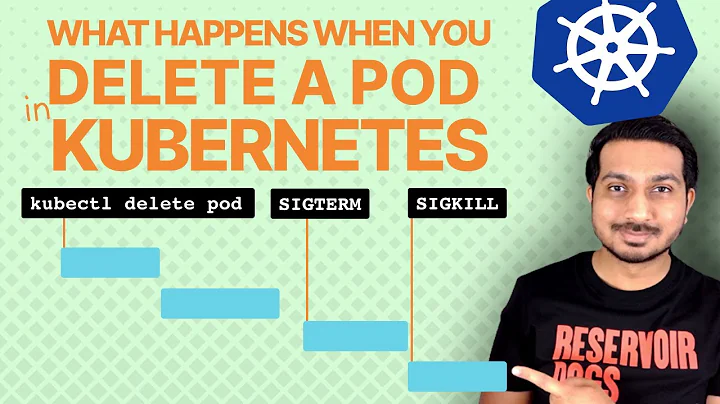Kubernetes: Can't delete PersistentVolumeClaim (pvc)
Solution 1
This happens when persistent volume is protected. You should be able to cross verify this:
Command:
kubectl describe pvc PVC_NAME | grep Finalizers
Output:
Finalizers: [kubernetes.io/pvc-protection]
You can fix this by setting finalizers to null using kubectl patch:
kubectl patch pvc PVC_NAME -p '{"metadata":{"finalizers": []}}' --type=merge
Ref; Storage Object in Use Protection
Solution 2
You can get rid of editing your pvc! Remove pvc protection.
- kubectl edit pvc YOUR_PVC -n NAME_SPACE
- Manually edit and put # before this line

- All pv and pvc will be deleted
Solution 3
I'm not sure why this happened, but after deleting the finalizers of the pv and the pvc via the kubernetes dashboard, both were deleted. This happened again after repeating the steps I described in my question. Seems like a bug.
Solution 4
The PV is protected. Delete the PV before deleting the PVC. Also, delete any pods/ deployments which are claiming any of the referenced PVCs. For further information do check out Storage Object in Use Protection
Solution 5
For me pv was in retain state, hence doing the above steps did not work.
1st we need to change policy state as below :
kubectl patch pv PV_NAME -p '{"spec":{"persistentVolumeReclaimPolicy":"Delete"}}'
Then delete pvc as below.
kubectl get pvc
kubectl delete pvc PVC_NAME
finally, delete pv with
kubectl delete pv PV_NAME
Related videos on Youtube
Yannic Bürgmann
Updated on February 17, 2022Comments
-
 Yannic Bürgmann about 2 years
Yannic Bürgmann about 2 yearsI created the following persistent volume by calling
kubectl create -f nameOfTheFileContainingTheFollowingContent.yamlapiVersion: v1 kind: PersistentVolume metadata: name: pv-monitoring-static-content spec: capacity: storage: 100Mi accessModes: - ReadWriteOnce hostPath: path: "/some/path" --- apiVersion: v1 kind: PersistentVolumeClaim metadata: name: pv-monitoring-static-content-claim spec: accessModes: - ReadWriteOnce storageClassName: "" resources: requests: storage: 100MiAfter this I tried to delete the pvc. But this command stuck. when calling
kubectl describe pvc pv-monitoring-static-content-claimI get the following resultName: pv-monitoring-static-content-claim Namespace: default StorageClass: Status: Terminating (lasts 5m) Volume: pv-monitoring-static-content Labels: <none> Annotations: pv.kubernetes.io/bind-completed=yes pv.kubernetes.io/bound-by-controller=yes Finalizers: [foregroundDeletion] Capacity: 100Mi Access Modes: RWO Events: <none>And for
kubectl describe pv pv-monitoring-static-contentName: pv-monitoring-static-content Labels: <none> Annotations: pv.kubernetes.io/bound-by-controller=yes Finalizers: [kubernetes.io/pv-protection foregroundDeletion] StorageClass: Status: Terminating (lasts 16m) Claim: default/pv-monitoring-static-content-claim Reclaim Policy: Retain Access Modes: RWO Capacity: 100Mi Node Affinity: <none> Message: Source: Type: HostPath (bare host directory volume) Path: /some/path HostPathType: Events: <none>There is no pod running that uses the persistent volume. Could anybody give me a hint why the pvc and the pv are not deleted?
-
 Yannic Bürgmann almost 6 yearsI tried to delete both. The pv and the pvc. As you can see in the describe output both are in terminating state
Yannic Bürgmann almost 6 yearsI tried to delete both. The pv and the pvc. As you can see in the describe output both are in terminating state -
 Vit almost 6 yearsWhat platform are you using? Have you tried to delete using
Vit almost 6 yearsWhat platform are you using? Have you tried to delete usingkubectl create -f nameOfTheFileContainingTheFollowingContent.yaml? -
Pavel Anni over 5 yearsI had a similar problem: PVC didn't want to die and because of that the project was in "Terminating" state forever. I did
oc edit pvc/protected-pvc -n myprojectand deleted those two lines about finalizers. Both PVC and the projects were gone immediately. I agree it's probably a bug because it should not behave that way. I didn't have any pods running in that project, just that PVC. -
Pentux about 5 years
Recycleis deprecated now -
 Yannic Bürgmann about 5 years"There is no pod running that uses the persistent volume"
Yannic Bürgmann about 5 years"There is no pod running that uses the persistent volume" -
 CryptoFool about 5 yearsI just came across this same problem, with this being the solution for me too...delete the constraints. This isn't a "thank you" comment. Rather, I'm adding this because it's 7+ months later and this problem still seems to exist in the wild, and thought new readers might benefit in knowing that. I'm running the latest 'minikube' (installed and built just a few days ago) behind an up to date "Docker for Mac".
CryptoFool about 5 yearsI just came across this same problem, with this being the solution for me too...delete the constraints. This isn't a "thank you" comment. Rather, I'm adding this because it's 7+ months later and this problem still seems to exist in the wild, and thought new readers might benefit in knowing that. I'm running the latest 'minikube' (installed and built just a few days ago) behind an up to date "Docker for Mac". -
 CryptoFool about 5 years...I'm following an online tutorial. I don't know if this is related to this bug, but the behavior I get is different than the instructor's. He creates a new PVC and its state is initially "Pending". Only when he manually creates a PV does the state of the PVC become "bound". In my case, it seems that creating the PVC using the same command he does immediately creates a PV to use the PVC allocated storage. Does anyone know why this is?
CryptoFool about 5 years...I'm following an online tutorial. I don't know if this is related to this bug, but the behavior I get is different than the instructor's. He creates a new PVC and its state is initially "Pending". Only when he manually creates a PV does the state of the PVC become "bound". In my case, it seems that creating the PVC using the same command he does immediately creates a PV to use the PVC allocated storage. Does anyone know why this is? -
 j3ffyang almost 5 yearsI met this issue again today. 2 PVs, without Pod and PVC associated, turned into
j3ffyang almost 5 yearsI met this issue again today. 2 PVs, without Pod and PVC associated, turned intoterminatingstate forever, when being deleted. To fix it, I rankubectl patch pv local-pv-324352d9 -n ops -p '{"metadata":{"finalizers": []}}' --type=mergeThen the PV is gone. Thanks @Xiak hint -
 Rakesh Gupta almost 5 yearsThis comment has helped me with deleting a volume that was stuck in Terminating state. thanks.
Rakesh Gupta almost 5 yearsThis comment has helped me with deleting a volume that was stuck in Terminating state. thanks. -
Uliysess almost 5 yearsAs answer is not complete in my opinion (not explaining steps of a solution for laics) - You can remove Finalizers in dashboard in YAML of particular PV. Additionally you can do that in terminal by:
kubectl patch pvc NAME -p '{"metadata":{"finalizers":null}}',kubectl patch pod NAME -p '{"metadata":{"finalizers":null}}'. Source github.com/kubernetes/kubernetes/issues/… -
 Yannic Bürgmann almost 5 yearsAlready mentioned in another answer: stackoverflow.com/a/56182934/2576531
Yannic Bürgmann almost 5 yearsAlready mentioned in another answer: stackoverflow.com/a/56182934/2576531 -
 jacktrade over 4 yearsthat solution works best than edit solution accross corporate firewalls
jacktrade over 4 yearsthat solution works best than edit solution accross corporate firewalls -
 Yannic Bürgmann about 4 years@codersofthedark it does not explain the cause. Of course it is protected. That's what I already mentioned in my question. But the volume wasn't used by any Pod => protection shouldn't have any effect.
Yannic Bürgmann about 4 years@codersofthedark it does not explain the cause. Of course it is protected. That's what I already mentioned in my question. But the volume wasn't used by any Pod => protection shouldn't have any effect. -
 phydeauxman about 4 yearsI am having this issue and when I tried the command above to patch the pvc, kept getting the error
phydeauxman about 4 yearsI am having this issue and when I tried the command above to patch the pvc, kept getting the errorunable to parse "'{metadata:{finalizers:": yaml: found unexpected end of stream -
DiveInto almost 4 yearsfor my case, the PVCs are protected cuz I only deleted StatefulSet, not the underlying pods, so the PVCs are still being used by Pods, that's why it is in TERMINATING phase
-
weberc2 about 3 yearsI'm on GKE and something seems to be setting the finalizer back immediately. :/
-
Rajan Panneer Selvam almost 3 yearsInstead of two commands, it can be done as 'kubectl edit pvc pvc_name', then remove the section and save. BTW, as per the original question, the author removed the PVC - but that operation failed due to other reasons as specified in the above answers.
-
 haruhi over 2 yearsThank you! this works for me
haruhi over 2 yearsThank you! this works for me -
 Yannic Bürgmann about 2 yearsThis is the expected behaviour for protected volumes. When the deployment still uses the volume it cant be deleted.
Yannic Bürgmann about 2 yearsThis is the expected behaviour for protected volumes. When the deployment still uses the volume it cant be deleted.





![[ Kube 23 ] Dynamically provision NFS persistent volumes in Kubernetes](https://i.ytimg.com/vi/AavnQzWDTEk/hq720.jpg?sqp=-oaymwEcCNAFEJQDSFXyq4qpAw4IARUAAIhCGAFwAcABBg==&rs=AOn4CLAfdTFPGf0d7yWYHz78setedICWiQ)



